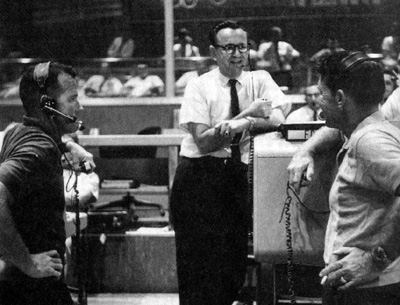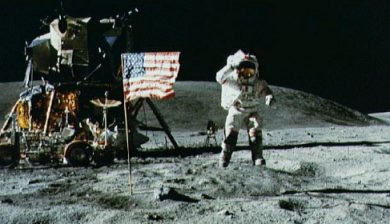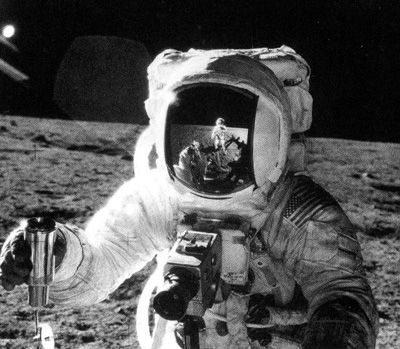
|
|
The Mercury Program
Mission: Mercury-Redstone 3
Date: 5 May 1961
Crew: Al Shepard
Spacecraft call signs: Freedom 7
Description: 1st manned US suborbital flight
Backup crew: John Glenn
Flight directors: Chris Kraft
CapComs: Deke Slayton, Gordo Cooper
Launch location: Cape Canaveral, Pad 5
Recovery ship: USS Lake Champlain
Mission: Mercury-Redstone 4
Date: 21 July 1961
Crew: Gus Grissom
Spacecraft call signs: Liberty Bell 7
Description: 2nd manned US suborbital flight; Capsule sinks when hatch blows prematurely but is recovered 38 years later
Backup crew: John Glenn
Flight directors: Chris Kraft
CapComs: Al Shepard, Deke Slayton
Launch location: Cape Canaveral, Pad 5
Recovery ship: USS Randolph Mission: Mercury-Atlas 6
Date: 20 February 1962
Crew: John Glenn
Spacecraft call signs: Friendship 7
Description: 1st manned US orbital flight
Backup crew: Scott Carpenter
Flight directors: Chris Kraft
CapComs: Gordo Cooper, Wally Schirra, Al Shepard, Gus Grissom
Launch location: Cape Canaveral, Pad 14
Recovery ship: USS Noa Mission: Mercury-Atlas 7
Date: 24 May 1962
Crew: Scott Carpenter
Spacecraft call signs: Aurora 7
Description: 2nd manned US orbital fight; 1st astronaut to eat food in space
Backup crew: Wally Schirra
Flight directors: Chris Kraft
CapComs: Gus Grissom, Al Shepard, Deke Slayton, Gordo Cooper
Launch location: Cape Canaveral, Pad 14
Recovery ship: USS Intrepid Mission: Mercury-Atlas 8
Date: 3 October 1962
Crew: Wally Schirra
Spacecraft call signs: Sigma 7
Description: 3rd manned US suborbital flight; 1st engineering flight
Backup crew: Gordo Cooper
Flight directors: Chris Kraft
CapComs: Deke Slayton, Gus Grissom, Al Shepard, John Glenn
Launch location: Cape Canaveral, Pad 14
Recovery ship: USS Kearsarge Mission: Mercury-Atlas 9
Date: 15 - 16 May 1963
Crew: Gordo Cooper
Spacecraft call signs: Faith 7
Description: 4th manned US orbital flight; Last flight of the program; 1st US flight to test effects of extended spaceflight (34 hours)
Backup crew: Al Shepard
Flight directors: Chris Kraft, John Hodge
CapComs: Al Shepard, Wally Schirra, John Glenn, Neil Armstrong
Launch location: Cape Canaveral, Pad 14
Recovery ship: USS Kearsarge
|
| |
The Gemini Program
Mission: Gemini-Titan 3
Date: 23 March 1965
Crew: Gus Grissom - Cdr; John Young - Co-pt
Spacecraft call signs: Gemini 3/Molly Brown
Description: 1st manned flight of program; 1st US 2-manned space flight; Grissom becomes 1st man to fly twice in space
Backup crew: Wally Schirra, Tom Stafford
Flight directors: Chris Kraft
CapComs: Gordo Cooper, Pete Conrad, Roger Chaffee
Launch location: Cape Kennedy, Pad 19
Recovery ship: USS IntrepidMission: Gemini-Titan IV
Date: 3 - 7 June 1965
Crew: Jim McDivitt - Cdr; Ed White - Co-pt
Spacecraft call signs: Gemini IV [Little Eva (Unofficial)]
Description: White becomes the 1st American to walk in space on 4 June 1965
Backup crew: Frank Borman, Jim Lovell
Flight directors: Chris Kraft, Gene Kranz, John Hodge
CapComs: Al Shepard, Gus Grissom, Walt Cunningham, Frank Borman
Launch location: Cape Kennedy, Pad 19
Recovery ship: USS Wasp Mission: Gemini-Titan V
Date: 21 - 29 August 1965
Crew: Gordo Cooper - Cdr; Pete Conrad - Co-pt
Spacecraft call signs: Gemini V
Description: 121 orbits, longest manned flight to date
Backup crew: Neil Armstrong, Elliot See*
Flight directors: Chris Kraft, Gene Kranz, John Hodge
CapComs: Gus Grissom, Jim McDivitt, Buzz Aldrin, Neil Armstrong
Launch location: Cape Kennedy, Pad 19
Recovery ship: USS Lake Champlain
Mission: Gemini-Titan VI
Date: 15 - 16 December 1965
Crew: Wally Schirra - Cdr; Tom Stafford - Co-pt
Spacecraft call signs: Gemini VI
Description: 1st space rendezvous (with Gemini VII)
Backup crew: Gus Grissom, John Young
Flight directors: Chris Kraft, Gene Kranz, John Hodge
CapComs: Al Bean, Elliot See*, Gene Cernan, Charlie Bassett*
Launch location: Cape Kennedy, Pad 19
Recovery ship: USS Wasp
Mission: Gemini-Titan VII
Date: 4 - 18 December 1965
Crew: Frank Borman - Cdr; Jim Lovell - Co-pt
Spacecraft call signs: Gemini VII
Description: 1st space rendezvous (with Gemini VI); Longest US flight to date (14 days) to test long duration spaceflight
Backup crew: Ed White, Mike Collins
Flight directors: Chris Kraft, Gene Kranz, John Hodge
CapComs: Al Bean, Elliot See*, Gene Cernan, Charlie Bassett*
Launch location: Cape Kennedy, Pad 19
Recovery ship: USS Wasp
Mission: Gemini-Titan VIII
Date: 16 - 17 March 1966
Crew: Neil Armstrong - Cdr; Dave Scott - Co-pt
Spacecraft call signs: Gemini VIII
Description: 1st docking of two spacecraft in orbit (with the Agena 8 target vehicle)
Backup crew: Pete Conrad, Dick Gordon
Flight directors: Gene Kranz, John Hodge
CapComs: Walt Cunningham, Jim Lovell, Keith Kundel*, Ken Mattingly
Launch location: Cape Kennedy, Pad 19
Recovery ship: USS Leonard F. Mason
Mission: Gemini-Titan IX
Date: 3 - 6 June 1966
Crew: Tom Stafford - Cdr; Gene Cernan - Co-pt
Spacecraft call signs: Gemini IX
Description: Agena rendezvous flight with an extended EVA; Most accurate splashdown to date
Backup crew: Jim Lovell, Buzz Aldrin
Flight directors: Gene Kranz, Cliff Charlesworth
CapComs: Buzz Aldrin, Neil Armstrong, Jim Lovell, Dick Gordon
Launch location: Cape Kennedy, Pad 19
Recovery ship: USS Wasp
Mission: Gemini-Titan X
Date: 18 - 21 July 1966
Crew: John Young - Cdr; Mike Collins - Co-pt
Spacecraft call signs: Gemini X
Description: Set new altitude record (476 miles high); 1st dual rendezvous (with Agena 8 & 10 targets); Collins becomes the 1st man to do 2 EVAs
Backup crew: Al Bean, C. C. Williams*
Flight directors: Glynn Lunney
CapComs: Gordo Cooper, Buzz Aldrin
Launch location: Cape Kennedy, Pad 19
Recovery ship: USS Guadalcanal
Mission: Gemini-Titan XI
Date: 12 -15 September 1966
Crew: Pete Conrad - Cdr; Dick Gordon - Co-pt
Spacecraft call signs: Gemini XI
Description: Achieved rendezvous with the Agena Target Vehicle on the 1st orbit; Shortest launch window in the Gemini program (2 seconds); Set new altitude record (850 miles high)
Backup crew: Neil Armstrong, Bill Anders
Flight directors: Glynn Lunney
CapComs: C. C. Williams, John Young, Al Bean
Launch location: Cape Kennedy, Pad 19
Recovery ship: USS Guam
Mission: Gemini-Titan XII
Date: 11 - 15 November 1966
Crew: Jim Lovell - Cdr; Buzz Aldrin - Co-pt
Spacecraft call signs: Gemini XII
Description: Longest EVA to date (Buzz Aldrin); Lovell becomes most travelled man in history; Last flight of the program
Backup crew: Gordo Cooper, Gene Cernan
Flight directors: Glynn Lunney
CapComs: Stu Roosa, Pete Conrad, Bill Anders
Launch location: Cape Kennedy, Pad 19
Recovery ship: USS Wasp
|
 Gordo Cooper, Chris Kraft & Wally Schirra prior to Wally's Mercury flight
Gordo Cooper, Chris Kraft & Wally Schirra prior to Wally's Mercury flight |
| |
The Apollo Program Mission: Apollo-Saturn 1
Date: 27 January 1967
Crew: Gus Grissom - Cdr; Ed White - CMP; Roger Chaffee - LMP
Spacecraft call signs: Apollo 1
Description: During a plugs out test on pad 34 a fire broke out in the CM cockpit asphyxiating the crew before the hatch could be opened; Due to be the 1st manned flight of the Apollo program
Backup crew: Wally Schirra, Donn Eisele, Walt Cunningham
Mission: Apollo-Saturn 7 (Saturn IB)
Date: 11 - 21 October 1968
Crew: Wally Schirra - Cdr; Donn Eisele - CMP; Walt Cunningham - LMP
Spacecraft call signs: Apollo 7
Description: 1st manned flight of the Apollo program; 1st US three-man flight; 1st use of TV in space
Backup crew: Tom Stafford, John Young, Gene Cernan
Flight directors: Glynn Lunney, Gene Kranz, Gerry Griffin
CapComs: Stu Roosa, Jack Swigert, Bill Pogue, Tom Stafford, Ron Evans, Gene Cernan
Launch location: Cape Kennedy, Pad 34
Recovery ship: USS Essex
Mission: Apollo-Saturn 8 (Saturn V)
Date: 21 - 27 December 1968
Crew: Frank Borman - Cdr; Jim Lovell - CMP; Bill Anders - LMP
Spacecraft call signs: Apollo 8
Description: 1st manned mission to the moon; 1st lunar orbit test of the CSM; Set a new speed record of 24,200 MPH
Backup crew: Neil Armstrong, Buzz Aldrin, Fred Haise
Flight directors: Cliff Charlesworth, Glynn Lunney, Milt Windler
CapComs: Gerry Carr, Mike Collins, Ken Mattingly, Neil Armstrong, Buzz Aldrin, Vance Brand, Fred Haise
Launch location: Kennedy Space Centre, Pad 39A
Recovery ship: USS Yorktown
Mission: Apollo-Saturn 9 (Saturn IB)
Date: 3 - 13 March 1969
Crew: Jim McDivitt - Cdr; Dave Scott - CMP; Rusty Schweickart - LMP
Spacecraft call signs: Apollo 9; CSM - Gumdrop; LM - Spider
Description: 1st test of the LM in space; 1st test of PLSS; 1st two-man EVA (Scott & Schweickart)
Backup crew: Pete Conrad, Dick Gordon, Al Bean
Flight directors: Gene Kranz, Gerry Griffin, Pete Frank
CapComs: Al Worden, Stu Roosa, Ron Evans, Pete Conrad, Dick Gordon, Al Bean
Launch location: Kennedy Space Centre, Pad 39A
Recovery ship: USS Guadalcanal
Mission: Apollo-Saturn 10 (Saturn V)
Date: 18 - 26 May 1969
Crew: Tom Stafford - Cdr; John Young - CMP; Gene Cernan - LMP
Spacecraft call signs: Apollo 10; CSM - Charlie Brown; LM - Snoopy
Description: 1st test of LM in lunar orbit; 1st use of colour TV in space
Backup crew: Gordo Cooper, Donn Eisele, Ed Mitchell
Flight directors: Glynn Lunney, Milt Windler, Pete Frank, Gerry Griffin
CapComs: Charlie Duke, Joe Engle*, Bruce McCandless*, Ed Mitchell, Jack Lousma
Launch location: Kennedy Space Centre, Pad 39A
Recovery ship: USS Princeton
Mission: Apollo-Saturn 11 (Saturn V)
Date: 16 - 24 July 1969
Crew: Neil Armstrong - Cdr; Mike Collins - CMP; Buzz Aldrin - LMP
Spacecraft call signs:Apollo 11; CSM - Columbia; LM - Eagle
Description: 1st manned lunar landing (Sea of Tranquility); Armstrong and Aldrin become the 1st & 2nd men on the moon
Backup crew: Jim Lovell, Bill Anders, Fred Haise
Flight directors: Gene Kranz, Glynn Lunney, Milt Windler, Cliff Charlesworth
CapComs: Bruce McCandless*, Charlie Duke, Ron Evans, Owen Garriott, Jack Schmitt, Don Lind*, Jim Lovell, Bill Anders, Ken Mattingly, Fred Haise
Launch location: Kennedy Space Centre, Pad 39A
Recovery ship: USS Hornet
Mission: Apollo-Saturn 12 (Saturn V)
Date: 14 - 24 November 1969
Crew: Pete Conrad - Cdr; Dick Gordon - CMP; Al Bean - LMP
Spacecraft call signs: Apollo 12; CSM - Yankee Clipper; LM - Intrepid
Description: 2nd manned lunar landing (Ocean of Storms); Conrad and Bean become the 3rd & 4th men on the moon; 1st pinpoint landing (535 feet from Surveyor III probe); Initiated a Lunar Nuclear Power Station
Backup crew: Dave Scott, Al Worden, Jim Irwin
Flight directors: Gerry Griffin, Glynn Lunney, Cliff Charlesworth., Pete Frank
CapComs: Gerry Carr, Ed Gibson, Don Lind*, Paul Weitz, Dave Scott
Launch location: Kennedy Space Centre, Pad 39A
Recovery ship: USS Hornet
Mission: Apollo-Saturn 13 (Saturn V)
Date: 11 - 17 April 1970
Crew: Jim Lovell - Cdr; Jack Swigert - CMP; Fred Haise - LMP
Spacecraft call signs: Apollo 13; CSM - Odyssey; LM - Aquarius
Description: 3rd attempted manned lunar landing (target: Fra Mauro Highlands); Lovell becomes the 1st man to fly to the moon twice; Liquid oxygen tank explodes in the SM and the mission is aborted before entering lunar orbit
Backup crew: John Young, (Jack Swigert), Charlie Duke
Flight directors: Gene Kranz, Glynn Lunney, Gerry Griffin, Milt Windler
CapComs: Jack Lousma, Joe Kerwin, Vance Brand
Launch location: Kennedy Space Centre, Pad 39A
Recovery ship: USS Iwo Jima
Mission: Apollo-Saturn 14 (Saturn V)
Date: 31 January - 9 February 1971
Crew: Al Shepard - Cdr; Stu Roosa - CMP; Ed Mitchell - LMP
Spacecraft call signs: Apollo 14; CSM - Kitty Hawk; LM - Antares
Description: 3rd manned lunar landing (Fra Mauro Highlands); Shepard and Mitchell become the 5th & 6th men on the moon; 1st use of MET; Medical and manufacturing experiments conducted in space; Al Shepard hits two golf balls on the surface of the moon
Backup crew: Gene Cernan, Ron Evans, Joe Engle*
Flight directors: Gerry Griffin, Pete Frank, Milt Windler, Gene Kranz, Glynn Lunney
CapComs: Bruce McCandless*, Gordon Fullerton*, Joe Engle*, Gene Cernan, Fred Haise, Ron Evans
Launch location: Kennedy Space Centre, Pad 39A
Recovery ship: USS New Orleans
Mission: Apollo-Saturn 15 (Saturn V)
Date: 26 July - 7 August 1971
Crew: Dave Scott - Cdr; Al Worden - CMP; Jim Irwin - LMP
Spacecraft call signs: Apollo 15; CSM - Endeavour; LM - Falcon
Description: 4th manned lunar landing (Hadley Rille); Scott and Irwin become the 7th & 8th men on the moon; 1st use of LRV on the moon
Backup crew: Dick Gordon, Vance Brand, Jack Schmitt
Flight directors: Gerry Griffin, Glynn Lunney, Milt Windler, Gene Kranz
CapComs: Joe Allen*, Robert Parker*, Gordon Fullerton*, Karl Henize*, Dick Gordon, Ed Mitchell, Jack Schmitt
Launch location: Kennedy Space Centre, Pad 39A
Recovery ship: USS Okinawa
Mission: Apollo-Saturn 16 (Saturn V)
Date: 16 - 27 April 1972
Crew: John Young - Cdr; Ken Mattingly - CMP; Charlie Duke - LMP
Spacecraft call signs: Apollo 16; CSM - Casper; LM - Orion
Description: 5th manned lunar landing (Descartes Highlands); Young and Duke become the 9th & 10th men on the moon; Highest lunar landing (at an elevation of 25,688 feet); Set a lunar speed record (11.2 MPH); Set a lunar distance record (travelled 22.4 miles from the LM)
Backup crew: Fred Haise, Stu Roosa, Ed Mitchell
Flight directors: Gerry Griffin, Gene Kranz
CapComs: Gordon Fullerton*, Anthony England*, Jim Irwin, Henry Hartsfield*, Ed Mitchell, Robert Overmyer*
Launch location: Kennedy Space Centre, Pad 39A
Recovery ship: USS Ticonderoga
Mission: Apollo-Saturn 17 (Saturn V)
Date: 7 - 19 December 1972
Crew: Gene Cernan - Cdr; Ron Evans - CMP; Jack Schmitt - LMP
Spacecraft call signs: Apollo 17; CMS - America; LM - Challenger
Description: 6th and last (to date) manned lunar landing (Valley of Taurus Littrow); Cernan and Schmitt become the 11th and 12th men on the moon; Longest stay on the moon of all Apollo landings (75 hours); 1st night launch of Saturn V
Backup crew: John Young, Stu Roosa, Charlie Duke
Flight directors: Gerry Griffin, Pete Frank, Hutchinson, Gene Kranz, Lewis
CapComs: Joe Allen*, Gordon Fullerton*, Robert Parker*, Al Shepard, Robert Overmyer*, Ken Mattingly, Stu Roosa, John Young
Launch location: Kennedy Space Centre, Pad 39A
Recovery ship: USS Ticonderoga
|
 Cdr John Young saluting on the surface
Cdr John Young saluting on the surface
of the moon during the Apollo 16 mission |
| |
The Skylab Program &
Apollo-Soyuz Test ProjectMission: Skylab-Saturn 1 (Saturn IB) [Officially Skylab 2]
Date: 25 May - 22 June 1973
Crew: Pete Conrad - Cdr; Joe Kerwin - Science Pilot; Paul Weitz - Pilot
Spacecraft call signs: Skylab; CSM - Apollo; Space Station: Skylab
Description: 1st crew to visit the US space station; Set a new world record of 673 hours in space; Conrad celebrates his 43rd birthday orbiting the Earth aboard Skylab; Kerwin becomes the 1st medical doctor in space
Backup crew: Rusty Schweickart, Story Musgrave*, Bruce McCandless*
Flight directors: Hutchinson, Shaffer, Puddy, Lewis, Milt Windler
CapComs: Henry Hartsfield*, Dick Truly*, Bob Crippen*, Rusty Schweickart, Bill Thornton*, Robert Parker*
Launch location: Kennedy Space Centre, Pad 39B
Recovery ship: USS Ticonderoga
Mission: Skylab-Saturn 2 (Saturn IB) [Officially Skylab 3]
Date: 28 July - 25 September 1973
Crew: Al Bean - Cdr; Owen Garriott - Science Pilot; Jack Lousma - Pilot
Spacecraft call signs: Skylab; CSM - Apollo; Space Station - Skylab
Description: 2nd crew to visit the US space station; Completed three 2-man EVAs
Backup crew: Vance Brand, Bill Lenior*, Don Lind*
Flight directors: Hutchinson, Shaffer, Puddy, Lewis, Milt Windler
CapComs: Henry Hartsfield*, Dick Truly*, Bob Crippen*, Robert Parker*, Story Musgrave*, Bruce McCandless*
Launch location: Kennedy Space Centre, Pad 39B
Recovery ship: USS New Orleans
Mission: Skylab-Saturn 3 (Saturn IB) [Officially Skylab 4]
Date: 16 November 1973 - 8 February 1974
Crew: Gerry Carr - Cdr; Ed Gibson - Science Pilot; Bill Pogue - Pilot
Spacecraft call signs: Skylab; CSM - Apollo; Space Station - Skylab
Description: 3rd and last crew to visit Skylab; Set a record for the most travelled humans of all time [to date] (34,469,696 miles); Set an 84 day endurance record (longest time spent weightless to date)
Backup crew: Vance Brand, Bill Lenoir*, Don Lind*
Flight directors: Hutchinson, Shaffer, Puddy, Lewis, Milt Windler
CapComs: Henry Hartsfield*, Dick Truly*, Bob Crippen*, Story Musgrave*, Bill Thornton*, Bruce McCandless*
Launch location: Kennedy Space Centre, Pad 39B
Recovery ship: USS New Orleans
Mission: Apollo-Soyuz Test Project
Date: 15 - 24 July 1975
US Apollo crew: Tom Stafford - Cdr; Vance Brand - CMP; Deke Slayton - DMP
USSR Soyuz crew: Alexsei Leonov - Cdr; Valeri Kubasov - Co-pt
Spacecraft call signs: ASTP; US - Apollo; USSR - Soyuz
Description: 1st international space mission; 1st docking of US and USSR spacecraft; 1st co-ordinated launch of 2 spacecraft from different countries; Deke Slayton becomes the last of the Original 7 to fly (16 years after selection)
US Backup crew: Al Bean, Ron Evans, Jack Lousma
US Flight directors: Chris Kraft, Puddy, Hutchinson, Lewis, Frank, Honeycutt
US CapComs: Dick Truly*, Bob Crippen*, Karol Bobko*, Richard Overmyer*
US Launch location:Kennedy Space Centre, Pad 39B
US Recovery ship: USS New Orleans
|

Alan Bean on the lunar surface during the Apollo 12 mission |
|